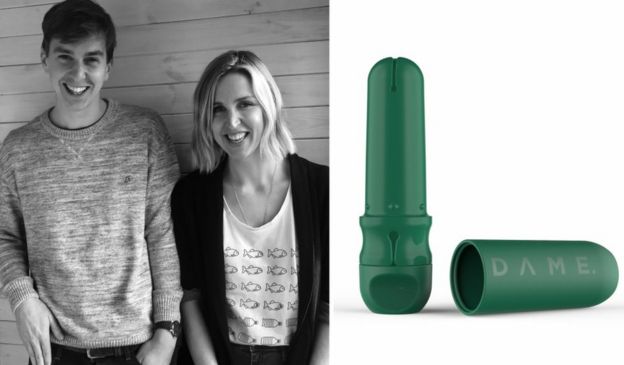source: http://www.bbc.com/news/world-43879789
Talking about periods openly can be difficult, and discussing menstrual waste can be even harder. While the fight against single-use plastics like straws and shopping bags has become a mainstream issue, activists and environmental groups say disposable menstrual products are part of the problem too.
How many women actually know their tampons and pads may have plastic in them? Unlike food products, there is no legal compulsion to list ingredients on their packaging, although most of this information is available online.
Pads, the product favoured around the world, can in some cases be made up of about 90% plastic - containing as much as four supermarket bags. Tampons are predominantly cotton and rayon but have components made up of polyester materials. Many come individually wrapped with plastic applicators.
The average woman is estimated to use, and throw away, in excess of 10,000 of these in her menstrual lifetime.
- Tampon tax: How much have you spent?
- The cheapest way to deal with your period
- Long read: banished for bleeding in Nepal
During its annual clean-up weekend in 2017, the Marine Conservation Society found a large increase in sewage-related debris on British beaches - including hundreds of menstrual pads, tampons and applicators. The problem inspired City to Sea, a group fighting ocean pollution, to start a #PlasticFreePeriod campaign.
Despite warnings on packaging that products like wipes and tampons aren't flushable, women continue to dispose of them this way, forcing water companies to spend huge amounts of money clearing blockages.
In countries without stringent disposal systems in place, these products can be found in the streets or on rubbish dumps being hand-sorted, leaving poor workers at huge health risk.
But through woman-to-woman advocacy and word of mouth, reusable products like cups, sponges and absorbable pants are growing in popularity around the world. Once a fringe choice, these environmentally friendlier options are being popularised by the internet.
How do cups work?
Two women helping to push the movement online are Kim Rosas and Amanda Hearn from YouTube channel Put A Cup In It. Based in the US, they aim to break down taboos with frank and open discussion about reusable products.
Menstrual cups, typically made of medical-grade silicone, are inserted into the vagina and collect, not absorb, menstrual blood. Their contents are periodically dumped, the cup cleaned, and the product reused. They may cost $30-40 (£20-30) but can be used for 10 years.
The idea of being that close with your own menstrual blood may make some women feel squeamish.
Activists believe a large part of this comes from exposure to marketing which characterises periods as a sanitary issue.
It can be seen in adverts that focus on a product's discretion, where menstrual blood is typically depicted as a mysterious blue liquid.
What are the cultural challenges?
The devices can be a life-changing solution in developing countries where deep cultural taboos and lack of sanitation access remains a major obstacle to women's education.
Ruby Cup, one brand, has spearheaded a "buy one, give one" programme that has provided sustainable options to more than 50,000 women in 10 countries with high levels of poverty.
 THE RUBY CUP
THE RUBY CUP
"Initially when people see the cup you get some very surprised faces - like is this going to go inside of me?" brand co-founder Julie Weigaard Kjaer says.
"But you'll get a few brave girls try it. They'll have a good experience and tell their peers."
Kenyan actress and model Ebby Weyime has developed a cup of her own which she now produces and sells locally.
"The majority of us live below the poverty line, so basic things like sanitary napkins are looked at as a luxury for most people," she says.
"Yes I can help a girl for January and February but what happens in March or April? After I found the cup I knew it was a long-time solution that could help girls for years."

She has found the lack of female sexual health awareness and enduring cultural taboos big hurdles to cup popularity in Africa.
"It's amazing how many women have no idea about their anatomy," she says.
"They've never seen how their vagina looks. Insertion is the main problem, so you just need girls to get past the worry and fear of that."
Similar barriers exist all around the world. While tampons are preferred in the US and Western Europe, they're actually culturally niche and menstrual pads overwhelmingly dominate the global market.
In India, Komal Khulbe, known online as the Delhi Fashion Blogger, has been praised by her fan base for breaking taboos by making a YouTube video about menstrual cups.
 THE DELHI FASHION BLOGGER
THE DELHI FASHION BLOGGER
"Most of the comments I get on the video are 'I'm not sexually active', 'does it mess up the hymen or not?'
"It's the same with tampons not being pushed in the media because they're worn in the body. It's a lot of word-of-mouth negative impression."
But environmentally friendly and culturally sensitive options are being developed there too - one brand, Saathi, has developed pads made from fully biodegradable plant-based fibres.
A solution for period poverty?
In Asian countries like South Korea, where prices of products have soared in recent years, menstruation can put incredible financial strain on women.
In 2016 a news story about a 16-year-old girl living with her disabled father shocked the country. She had been forced to fashion pads from shoe insoles.
- Taiwan's first crowdfunded menstrual cup
- Why used sanitary pads are being collected in India
- 'I couldn't mourn my grandmother because I had my period'
A scandal about toxic pads last year exacerbated the price problem there further.
 EASE & MORE
EASE & MORE
Ease & More, a social venture group, successfully helped in an effort to push South Korea's ministry of food and drug safety to approve the first cup for sale in December.
What other solutions are there?
Historically, a lot of women have used washable cloths to absorb blood.
Refined versions of this, in the form of reusable pads, have actually taken off as a plastic-free solution and are now being sold by retailers online.
Technological development has meant absorbable underwear has emerged as a solution. Thinx is the best known brand, partly due to a row over its provocative adverts on the New York subway system.
Their products are designed to absorb menstrual flow on light to medium days or act as a back-up method.
Maria Molland Selby, the company's CEO, said the idea had been born out of the developmental stagnation of disposable retail giants.
"They haven't innovated in decades. They're big, corporate. They've been around a while and have never had to have it at the top of their minds to figure out better products for women and as a result you have products that aren't best for the body."
For those who want to help reduce their period's environmental impact but still feel squeamish about washable options, there are alternatives.
Dame, a British organic menstrual product company, received an overwhelming response to an online Kickstarter campaign they launched earlier this year to develop their reusable tampon applicator.
"We love cups, we love washable pads but sadly they're not being used a lot," says one of brand's founders, Celia Pool.
"We saw an opportunity to allow women to use a product they feel comfortable with but in a much more sustainable way."
 DAME
DAME
"Every month, like clockwork, women come back. They may not even know the product's name, they just know if it's blue or green.
"You can understand why they [big brands] are not changing - so it's up to small businesses to offer people another option."
The company ended up overfunding their online campaign by almost 300% as videos about their product went viral.
Alec Mills, co-founder, says the pair were blown away by the online reaction - especially for an "unsexy tampon" product.
"It's a really good yardstick for the progression on our ability to talk about periods," he says.
"Now talking about the environment and their impact - it's been a big double step."
Questions:
1. When you go shopping, would you consider the product made by environmental friendly materials or use reusable alternatives? Like stainless straw, digital book, reusable cup or chopsticks, etc.
2. Do you think how we can do to reduce the waste created by human beings? Reducing the use of plastic products, giving up the idea of fast fashion, making the recycling easier and more efficient?


 留言列表
留言列表
